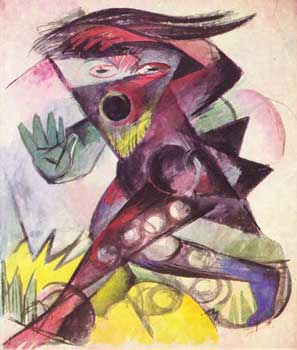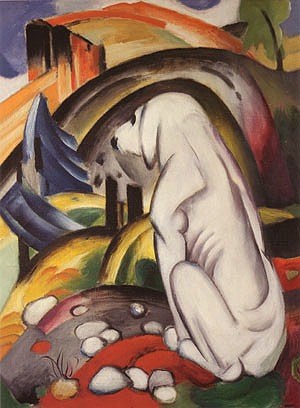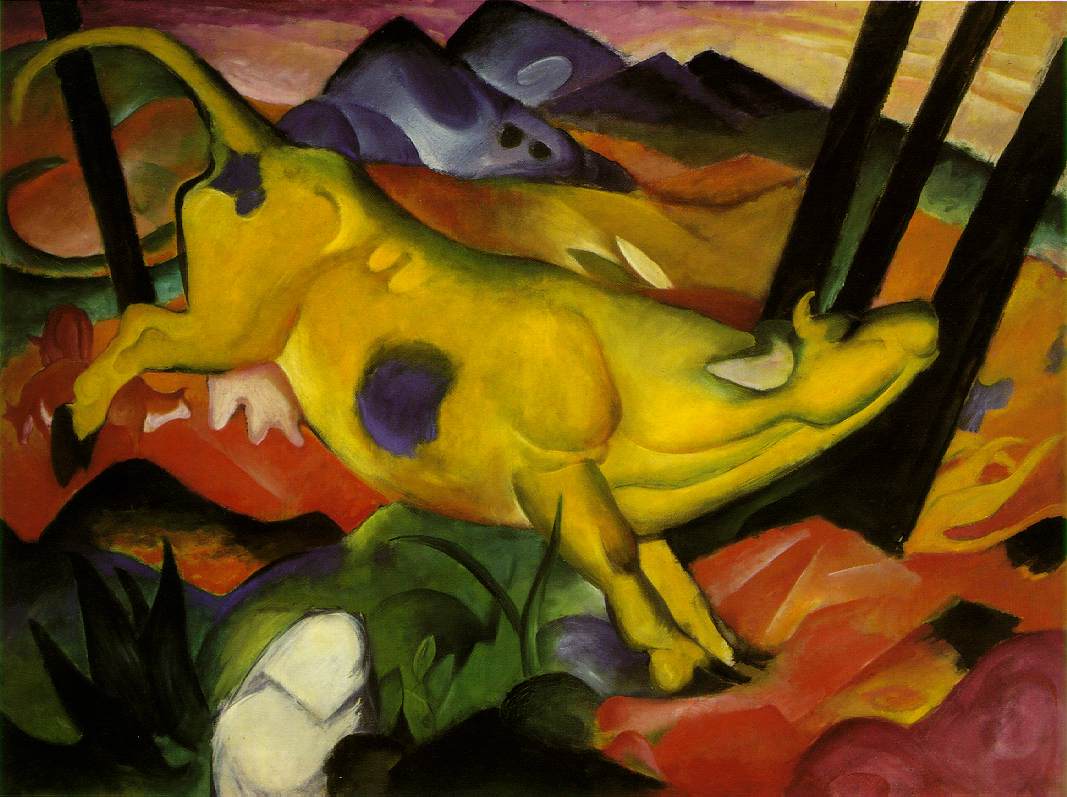
by Jean Marie Carey | 12 Jan 2018 | Art History, August Macke, Franz Marc, Re-Enactments© and MashUps
My research about the 1914 Franz Marc essay »Das abstrakte Theater« and Marc’s collaboration with Hugo Ball on an intended production of The Tempest has been published in a special arts issue of Empty Mirror. The fun long title of the article is “The Tempest and the Savages: Franz Marc, Hugo Ball, and a Decisive Moment in Dada-Expressionist Theater With a Special Appearance by August Macke,” and this piece contains important breaking historical avant-garde news.

Fig.01: Franz Marc, Fragmentary First Page of „Das abstrakte Theater,“ 1914. Das Archiv für Bildende Kunst im Germanischen Nationalmuseum, Nürnberg, Germany.
Here is the abstract: This article discusses the 1914 Franz Marc essay “Das abstrakte Theater” and the events surrounding an “Expressionist” production of Shakespeare’s Der Sturm planned by Marc and Hugo Ball the same year. Marc’s position in this detour from painting and writing can be understood in terms of his embrace of “die ‘Wilden’” – “the ‘Savages’” – an idea Marc introduces in 1912’s Blaue Reiter Almanac – as a metaphorical aspiration and as a state of being for both artists and the public as patrons of the arts and citizens of modernity. I also bring recognition to August Macke’s background in theatrical theory and design in terms of how this influenced Marc, particularly in analysis of the artists’ collaboration on Macke’s contribution to the Blaue Reiter Almanac, the essay “Die Masken,” and how this relates to the Der Sturm project. I propose a way of understanding how Marc’s beliefs in the paradoxically beneficial power of destruction dovetailed with Ball’s theology. In the context of this background information I give close reading of paintings Marc made of the Caliban and Miranda characters from Der Sturm. I also correct inaccuracies in the record regarding the chronologies of this encounter between these protagonists of Dada and Expressionism, and in our understanding of Marc’s text itself. Viewing this data in a holistic manner allows new interpretations of influences and collaborations amid the historical avant-garde.
It is great working with Denise Enck at Empty Mirror so it would be nice to look at the article on the Empty Mirror website, but if you would like a PDF of the article there is one here and also at Humanities Commons.

Fig.04: Franz Marc, Miranda, 1914. ( Tempera, 46 x 39.5 cm.) Kunstmuseum Basel, Kupferstichkabinett der öffentlichen Kunstsammlung, Switzerland.

Fig.03: Franz Marc, Caliban, 1914. (Figure for Shakespeare’s „Der Sturm“. Tempera, 46 x 39.5 cm.) Kunstmuseum Basel, Kupferstichkabinett der öffentlichen Kunstsammlung, Switzerland.

by Jean Marie Carey | 16 Mar 2016 | Animals in Art, Art History, August Macke, Dogs!, Expressionismus, Franz Marc, German Expressionism / Modernism
 Indexical photo with authorial shadow; graves of Franz and Maria Marc
Indexical photo with authorial shadow; graves of Franz and Maria Marc
On 4 March 2016, the 100th anniversary of the death of the painter, animal lover, writer, and ever-elusive person Franz Marc, I visited Marc’s grave in Kochel. Initially I had intended to spend the day between the Lenbachhaus and the Pinakothek der Moderne in München immersed in the paintings I have studied now for many years. But in truth I am devoted to Marc’s life as much as his art, and it seemed more right to take make a pilgrimage and pay respects in the proper sense of the word in the tiny Bavarian town where Marc lived off and on.
This trip was covered on the now-silent Franz Marc Twitter account and received much support and nice wishes from many kind souls.
It was a very emotional experience and had some typical Bavarian humorous adventures as well. I arrived on the regional train at about 11:00 on a dazzling clear, cold day, with most of the snow from the previous week’s blizzard still on the ground. The Ammergau Alps, what Marc called „das blaues Land“, glowed. Inserting itself into this majestic, somber first act was the fact that, in Kochel, Ruhezeit on Fridays apparently begins at 11:00…and this was a very intense Ruhezeit too…everything had abruptly closed, including the flower shop where I had intended to get some violets. I should add that all the flowers and plants were just sitting there outside, and the doors to the shop were open, but the lights were off and the people away being quiet. This was the same at other shops – I have always found it very amusing that in places where Ruhezeit is taken seriously, lunch places also close, even though Ruhezeit is at lunch time, and Kochel takes Ruhezeit quite seriously. In fact it was Friday Ruhezeit the entire time I was there. I stayed until 16:00, the hour of Marc’s death.
(more…)

by Jean Marie Carey | 3 Mar 2016 | Animals, Animals in Art, Art History, Expressionismus, Franz Marc, German Expressionism / Modernism

Franz Marc’s palette, from the archives of the Franz Marc Museum, Kochel.
Franz Marc’s “Aphorism 82,” from Die 100 Aphorismen, 1915.
“Ich sah das Bild, das in den Augen des Teichhuhns sich bricht, wenn es untertaucht: die tausend Ringe, die jedes kleine Leben einfassen, das Blau der flüsternden Himmel, das der See trinkt, das verzückte Auftauchen an einem andern Ort, – erkennt, meine Freunde, was Bilder sind: das Auftauchen an einem anderen Ort.”
“I saw what the moorhen sees as it dives: the thousand rings that encircle each little life, the blue of the whispering sky swallowed by the lake, the enraptured moment of surfacing in another place. Know, my friends, what images are: the experience of surfacing in another place.”

by Jean Marie Carey | 11 Jan 2016 | Animals, Animals in Art, Art History, Dogs!, Expressionismus, Franz Marc, German Expressionism / Modernism
In the spirit of rebirth an excerpt from my research about Franz Marc’s visualization of a kind of pantheistic utopia, followed by an introduction and explanation about this new website and some other breaking German Modernism news.
§ § §
Though it doesn’t seem as if these two images appended here could possibly be related, they do have a commonality – the figures are in a state of private reverie that is between sleep and wakefulness.

Franz Marc, Der Traum, 1912.
Franz Marc himself charaterized his mode of trying to perceive as the animal as if in a state of somnambulism, partly conscious yet also given over to the transformative experience of being another, in this dream-like state. The animals to Marc possessed in their purity a sort of natural extraconsciousness. His work has numerous examples of figures in such a “sleepwalking” state, corresponding to the posture of animals, and also people, in a relaxed posture reclining into a receptive earth. This natural somnambulism blurred what was conventionally taken to be a distinction between people and animals, that animals are innate and instinctive, whereas humans can return to this state only in dreams.
In 1911, Marc had written an interesting personal aside in his journal:
[Können wir uns ein Bild machen, wie wohl Tiere uns und die Natur sehen?]
Gibt es für Künstler eine geheimnisvollere Idee als die [Vorstellung], wie sich wohl die Natur in dem Auge eines Tieres spiegelt? Wie sieht ein Pferd die Welt oder ein Adler, ein Reh oder ein Hund? Wie armselig, [ja] seelenlos ist unsre [Gewohnheit] Konvention, Tiere in eine Landschaft zu setzen, die unsren Augen zugehört statt uns in die Seele des Tieres zu versenken, [daß wir das seinen Blick Weltbild] um dessen Bilderkreis zu erraten.
[Diese Betrachtung soll keine müßige causerie sein, sondern uns zu den Quellen der Kunst führen.]1
We can see this interest in the perception of animals reflected not just in Marc’s belief in the inherent Beseeltheit [2] of animals but also in his knowledge of contemporary zoology research taking place at the end of the 19th and beginning of the 20th centuries, for example, the writings of Wilhelm Bölsche on plant and animal taxonomy[3] and more clinical examinations, such as studies about how the retinae of insects’ eyes functioned.[4]
Thus what we think of now as “the question of the animal” was under Marc’s consideration in suprisingly contemporary terms, and should not be considered merely an outflow of his private, sentimental feelings about his pets. Like Kandinsky, Marc was curious as to whether there was a tangible basis for their claims that there existed unseen dimension in the regular order of the world but which had become invisible to callous, spiritually deprived humans.
The sketch, Liegender Hund (Russi), (and note also the title) shows that even before he began to wrangle with the problem of color, Marc was busy practicing making copies and models for his later paintings, sketches which nonetheless stood as discrete works for Marc, since, in his somewhat haphazard fashion, he also named and numbered them.
Unlike Paul Gauguin, from whom he certainly drew upon for ideas about content and color, to Marc, nude women in a natural setting were not excuses for a prurient gaze but rather these women, like Marc’s contemplative animals, symbolized innocence and purity, and were associated with the reclamation of paradise. Dreaming animals and people stood for a somnambulant state marking a kind of emotional perception that synaesthetically included auratic impressions and warmth.[5] In his painting Der Traum in which a “Wilden” woman sits cross-legged. Marc blends this image of longing for an original paradise with the European idea of paradise, where the wild lion, like that of St. Jerome, lives in peaceful harmony with horses and humans. Marc’s Animalisierung is in evidence here. Like “wild” people, animals as envisaged by Marc display a natural attunement to the spheres, having been born directly into their instincts, which modern humans – expelled from paradise – have lost.
(more…)

by Jean Marie Carey | 6 Apr 2015 | Animals, Animals in Art, Art History, August Macke, Dogs!, Expressionismus, Franz Marc, German Expressionism / Modernism, LÖL

Hund vor der Welt, Franz Marc (1912). Oil on canvas, 118 by 83 centimetres, private collection, Switzerland
I write about this painting a lot – in fact I once, for quite a long time, devoted my academic research solely to this painting – but I realised I don’t often say anything about it in this space. So here is a little excerpt not from my current chapters but from a side project.
§ § §
Franz Marc made an innovative painting – a metaphysical genre portrait of his dog Russi – called Hund vor der Welt in the spring of 1912. The large vertical canvas shows the white hound seated on a hillside, facing the sun and the landscape at an angle across an indeterminate space. We have an account of what Marc had in mind in making this image in particular and Marc’s other thoughts about painting his frequent model.[1] There is also a substantial amount of documentation about Russi, the dog, who, as the artist’s constant companion, was a character who populated the art, photographs, and writing of other people. We even know where Russi was born, how he came as a puppy to live with Marc, and when he died.[2] So despite its slightly whimsical affect, Hund vor der Welt is an image of a real dog about whom much historical information is available. Marc made many paintings in which Russi also appears as a peripheral regular “character;” he leads the way in Im Regen (1912) and leaps after Die gelbe Kuh (1911).
August Macke, who came into frequent contact with Russi and made his own drawings of the dog, prevailed upon Marc to change the name of the painting from the one Marc originally had in mind, So wird mein Hund die Welt sieht.3 We know from Marc that he wanted to show Russi in thought, so the dog’s seated posture suggests that this is what is happening in the stillness. The strange view of the landscape Russi “sees” is nonetheless completely identifiable as a typical one from around Sindelsdorf where Marc lived. By placing buildings in the recognizable, managed farmlands of Bavaria, Marc suggests that people and animals are part of the same ecology, which, for dogs as the primary animal of domestication, is certainly true.
Russi did not have the life of a working dog, instead, with Marc, dividing his time between Munich, Berlin, and the small towns of Sindelsdorf and Ried. Russi lost part of his tail in 1911, an adjustment to his appearance that is reflected in his 1912 portrait. This shows that Marc had a commitment to showing morphologically accurate details even about the animals he painted, even as the paintings themselves broke with academic naturalism.

Die gelbe Kuh,
Franz Marc, 1911
189.2 × 140.52 cm
Oil on canvas
Solomon R. Guggenheim Museum, New York. That is Russi Marc in the lower left corner.
[1] Franz Marc, Briefe, Schriften und Aufzeichnungen, (Leipzig: Kiepenheuer, 1989), 11. Observing Russi at this moment, Marc wonders: “Ich möchte mal wissen, was jetzt in dem Hund vorgeht.”
[2] Marc, Briefe, 196-197.
[3] Franz Marc, August Macke, Briefwechsel, (Köln: DuMont, 1964), 124-126.








